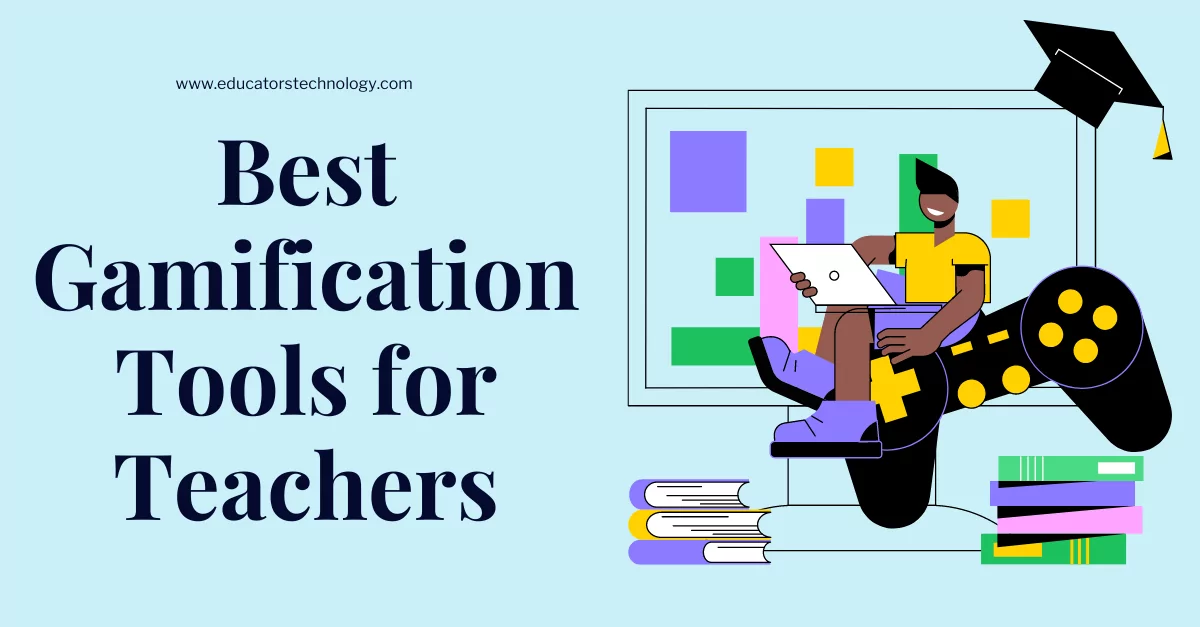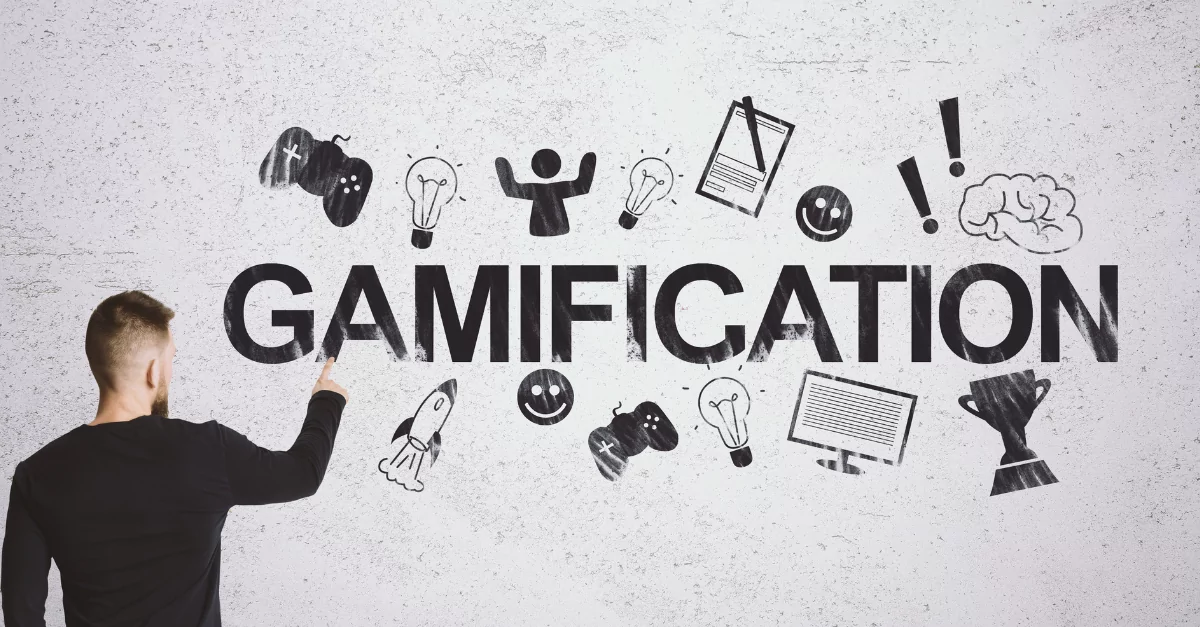Gamification tools for teachers are the topic of our blog post today!
Gamification is a cross-disciplinary concept that has been adopted in several sectors including marketing, healthcare, professional development trainings, politics, among others. By definition, gamification is “the incorporation of game elements into non-game settings” 1 .
In education, the concept of gamification has especially gained traction during the last decade or so due mainly to the advance of web technologies and mobile applications.
Gamification of education, therefore, refers to ” a developing approach for increasing learners’ motivation and engagement by incorporating game design elements in educational environments” 2 .

Gamified teaching is all about incorporating the educational power of games into instructional practice. Generally speaking, games, given their built-in mechanics which draw on incentivization and reward system, tend to drive motivation and motivation drives engagement.
Using games with your students will not only enhance their motivation and increase their participation but will also boost their overall learning.
The purpose of today’s post is to share with you some of the best tools to help you gamify your teaching (you can also check this collection of game-based learning books).
These are all platforms that have enjoyed and are still enjoying a growing popularity among the education community. Using them will enable you to easily incorporate the ethos of gamified education allowing you to create gameful learning experiences in class.
Gamification Tools for Teachers
Here are our top picks for gamification tools for teachers:
1. Kahoot
Kahoot is a game-based learning website that allows teachers and students to create, explore, and play a wide variety of educational games.
Kahoot is simple and easy to use and its games can be played on any device. Students are not even required to login to play Kahoot games.
They can simply join using the shared PIN code. Kahoots are the games and challenges you create using the tools provided by the platform.
Your kahoots can embed various types of questions and answers. They can include media materials such as videos and images, and many more.
Kahoots can be hosted live in class (Teach mode) or be assigned as self-paced learning challenges that students can play at their own pace (Assign mode).
After kahoots are completed, teachers can access insights and stats on students performance and identify learning difficulties.
2. Gimkit
Gimkit is a game-show application designed for use with learners in and out of class. Teachers can set up classes, invite students to join, and start creating and sharing game quizzes known as kits.
Teachers can either choose to host a live game/kit in which case students join the play in real-time or assign kits as homework activities.
Gimkit games support both individual and team mode and boost engagement by providing students with incentives in the form of virtual money they earn for correct answers. Students can use the earned currency to buy power-ups and in-game items.
As students complete the kits, Gimkit automatically grades their submissions and provides teachers with detailed reports on the performance of both the whole class and individual students.
3. Quiziz
Quizizz is a game-based learning tool that you can use to engage students in deep and meaningful learning experiences. It allows you to create both teacher-paced and student-paced quizzes and lessons.
Using Quizizz editor, you can easily design your own quizzes embedding various types of questions (multiple choice, open ended, polls, fill in the blanks, etc.) and media (e.g., images, videos, voice clips, and audio recordings).
Alternatively, you can use Quizizz library to search thousands of ready-made quizzes and lessons spanning several subjects and grades.
You can adapt these quizzes to your teaching needs, edit them the way you want, import questions right into your quizzes and share them with your students.
Quizizz provides you with a powerful grading system that generates instantaneous performance reports providing you with a treasure trove of analytic data to use to prepare for remedial interventions and to help you in your lesson planning.
With a single click, you can share these reports with parents to keep them in the know of their kids learning progress.
4. Blooket
Blooket is a game-based learning platform that allows teachers to create educational games to share with students. You can host live games that students can play using a generated ID or assign games as homework for students to play at their own pace.
As a teacher, you can create your own question sets or use ready-made sets created by members of the Blooket community (Blooket lingo refers to games as question sets and I use both terms interchangeably in this review).
Students are not required to register to play the games. However, having a student’s account allows students to “track their stats, place in global leaderboard rankings, buy and sell Blooks, and participate in upcoming community-wide events!”
The way Blooket works is simple. Teachers host live games with unique game mode on their screen and students join the play using generated game IDs. Teachers also have the option to assign learning games as homework so that students can work on them at their own pace.
5. Quizlet
Quizlet is a web tool and a mobile app that boosts students learning through a number of study tools that include flashcards and game-based quizzes. As a teacher, you can create your own class on Quizlet and share study sets with your students.
You can either design your study sets from scratch or search for pre-made sets to customize and use in your teaching.

6. Quizalize
Quizalize is a gamified quiz making tool that you can use to drive students engagement, increase their participation, and enhance their learning. Teachers use Quizalize to create various types of quizzes that students can access using a generated code.
As students take their quizzes, teachers gather important insights and analytic data about their performance and track students progress in real time.
These reports are especially useful in formative assessment providing teachers with key data to help them plan effective interventions, provide differentiated learning opportunities for students, and inform their lesson planning and teaching strategies.
7. Pear Deck
Pear Deck is a tool that allows you to turn your presentations and lessons into interactive learning materials. The way Pear Deck works is simple and easy: First, make sure you install Pear Deck add-on in your Google Drive or your OneDrive.
Next open your Slides or PowerPoint presentation and add Pear Deck’s interactive features. You can add a number of question types including multiple choice, open-ended, Draggables, and more.
You can also use Pear Deck’s pre-made templates to design interactive presentations. Once your presentation is ready, you can present it to the whole class.
Students can join the session from any device with a web browser using a unique access code. Or, you can assign it as homework assignment for students to work on at their own pace.
8. Riddle
Riddle is a simple and easy to use quiz maker that allows you to create a wide variety of interactive quizzes, surveys, and polls. You can either use ready-made quiz templates or build your own quiz from scratch.
Riddle quizzes can contain various multimedia materials including videos, audio clips, images, GIFs, and MP4 video clips.
Riddle offers different sharing options including embedding quizzes in your website or blog or sharing them via email. As the audience takes your quizzes, Riddle generates detailed analytic reports allowing you to access data about your quiz views, shares, completion rates, and many more.
9. Baamboozle
Baamboozle is a game-based learning platform that contains over one million learning games ideal for use with students in and out of class. These games are designed by fellow teachers and educators and work for students of all ages and abilities.
Baamboozle also enables teachers to easily create their own games and share them with others. The site is simple and easy to use and no prior technical knowledge is required
10. Sporcle
Sporcle is an online trivia and quiz platform featuring tons of fun and engaging games. Sporcle quizzes are arranged into various categories including: Geography Quizzes, Music Quizzes, Movies Quizzes, Sports Quizzes, History Quizzes, Literature Quizzes, Science Quizzes, Language Quizzes, and many more.
Sporcle also enables you to create your own quizzes to share with others or to embed on your class blog or website. You can make your quiz private in which case it will not be shown in search or on your profile.
You can still share the link of your private quiz with friends, play it, and see results. You also have the option to create playlists on Sporcle and save your quizzes in a single place.
11. AhaSlides
AhaSlides is a presentation tool that allows you to create interactive and immersive presentations. It makes use of numerous interactive features such as live quizzes, polls, Q&A, scale ratings, word clouds, and spinner wheels to engage participants and creating immersive learning experiences.
AhaSlides works both online and offline and is also integrated with third party tools such as Zoom and PowerPoint. AhaSlides is simple and easy to use.
Choose from various available slide types to build your presentation, share the unique code of your presentation with your participants and lead them through your slides as they interact live with them.
12. PlayPosit
PlayPosit is an educational platform that allows you to create interactive video lessons, called bulbs, using videos from YouTube, Vimeo, Panopto, and several other video hosting sources. You can add different interactive features to videos and create immersive learning experiences for your students.
You can create a class on PlayPosit and invite students to join. You can assign bulbs and monitor students progress. PlayPosit also allows you to host live bulbs for the whole class to watch and interact with.
13. Edpuzzle
Edpuzzle is an educational platform that enables teachers to create and share annotated video lessons with their students. Teachers can use YouTube videos or upload their own, add questions, notes, and voiceovers and share with their students. Students watch the annotated videos and provide textual and audio responses.
Using Edpuzzle Gradebook, teachers can grade students answers, save their scores, and plan for future video lessons. Using the live mode, teachers can also project their video lessons live in class while students provide real-time responses which is helpful in remote learning settings.
14. Digipuzzle
Digipuzzle is a website that offers a wide variety of free online educational games for kids. These games target various skill areas from math and geography to science and human body. I spent some time browsing through and trying a number of these games and found them entertaining and fun.
The Education section in Digipuzzle features tons of educational games covering topics such as math, typing, geography, alphabets, programming, science, animals, history, music, back to school, and more. Each of these categories embed several game genres related to the main theme.
For instance, Math games are arranged into the following sub-categories: Fractions, Counting, Multiplications, Math till 10, Math till 20, etc. Each of these subcategories contain games that offer practice on a specific skill.
Final thoughts
In sum, gamification has revolutionized the educational landscape, infusing the dynamism of game elements into the often-rigid structure of traditional learning environments. It has not only carved a niche in education technology but proven to be a robust motivator and engagement booster for students. Tools like Kahoot, Gimkit, Quizizz, and their kin are more than just digital platforms—they are catalysts for a new kind of interactive learning that harnesses the inherent human love for play. Leveraging such tools can transform the classroom into an arena where education meets entertainment, thus fostering a rich, collaborative, and immersive learning experience that aligns with contemporary pedagogical practices.
References:
1. Lee, J. & Hammer, J. (2011). Gamification in education: What, how, why bother? Academic Exchange Quarterly.
2. Dichev, C. & Dcheva, D. (2017). Gamifying education: what is known, what is believed and what remains uncertain: a critical review. International Journal of Educational Technology in Higher Education, 14 (9). https://doi.org/10.1186/s41239-017-0042-5




